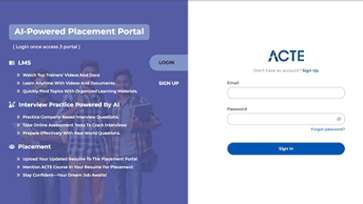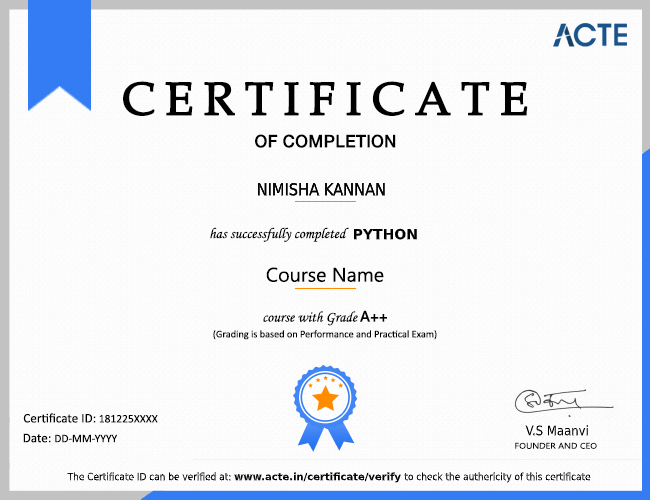The SAS Training at ACTE allows learners to obtain competence in implementing Advanced Analytics Techniques using the SAS Programming Language while being mentored by an expert. FITA's SAS Course in Chicago also familiarises you with crucial concepts such as SAS Macros, Proc SQL, Decision Trees, Predictive Analysis, Data Visualization, Modeling Techniques, and Statistical Analysis in real-time. By the end of this class, you will be able to build SAS Codes and Analyze a huge number of data sets using the SAS tool, as well as conduct advanced statistical techniques efficiently like a Pro.
Additional Info
Introduction:
SAS course will assist you in mastering sophisticated analytics techniques using the SAS language. You will master SAS macros, Machine Learning, PROC SQL, procedure, statistical analysis, and decision trees in this online training course. In addition, you will work on real-world projects and study for the SAS Certified Base Programmer certification exam.This SAS training course will assist you in understanding the disciplines of Business Analytics and Business Intelligence. After completing the programme, you will be capable of reading spreadsheets and databases, modifying data with SAS functions, and troubleshooting it.
This SAS Base certification training also covers data mining, data analytics, modelling approaches, data visualisation, predictive analysis, and insight extraction, all of which are explained using real-world case studies.
Who can Learn:
What will you study during this SAS certification course?
- SAS environment, as well as multiple windows.
- SAS Enterprise Reference.
- Logical statements, operators, and functions are all examples of logical expressions.
- Making datasets, as well as deploying compilation and execution.
- SAS graphics and executive summaries.
- SAS Advanced and SAS Base.
- Getting ready for the SAS Certified Base Programmer exam.
Who should enrol in this SAS training programme?
- IT and software developers, as well as architects.
- Professionals in Business Intelligence, Data Warehousing, ETL, Big Data, and Analytics.
- Managers of projects.
What are the requirements for enrolling in this SAS certification training?
- Without any requirements, anyone can learn how to use this programme.
- It will be advantageous if you are familiar with the principles of SQL.
Skills Covered:
- SAS as a foundation.
- SAS Advanced.
- SAS Personnel.
- SAS Procedures.
- PDV is an abbreviation for Personal Development (Backend).
- Missover.
- DLM.
- DSD delimiter.
- SAS File Format.
- Graphs from SAS.
- System of Output Delivery (ODS).
- Macros in SAS.
- System for Data Transformation.
Certification of SAS:
- This SAS course is intended to help you pass the SAS Certified Base Programmer test.
- The entire course content is aligned with this exam and will enable you easily pass it in order to get the best employment in top MNCs.
- As part of this programme, you will work on real-time projects and tasks that have huge significance in real-world industrial scenarios, allowing you to easily advance your career.
- There will be a quiz at the end of this training session that fully replicates the type of questions presented in the certification exam and will help you score higher.
Roles and Responsibilities:
SAS programmers' daily activities vary depending on the data they analyse and the statistical information they create. However, there are other key responsibilities linked with this job, including:
Raw Data Import and Export:
1. SAS programmers import and export raw data to populate and extract data from multiple databases.
Control Databases:
2. SAS programmers handle and maintain massive databases holding a large amount of data. Backing up data and combining it into statistics that reveal specifics are all part of this.
Construct Data Sets and Programs:
3. SAS programmers develop and write programmes to generate various data sets – such as tables, lists, and graphs – that display the exact information that the firm requires.
Create Macros:
4. SAS programmers create macros to simplify dataset instructions, making databases more searchable and information more accessible.
Data Analysis:
5. SAS programmers examine data and statistics to identify market trends, demographic breakdowns, and other pertinent business information.
Produce Reports:
5. SAS programmers develop daily operations reports for all levels of management that display important data.
Projects:
The Intellipaat course completion certificate will be provided upon completion of the project work (after expert assessment) and a quiz score of at least 60%. Top MNCs like as Ericsson, Cisco, Cognizant, Sony, Mu Sigma, Saint-Gobain, Standard Chartered, TCS, Genpact, Hexaware, and others recognise this qualification.
Advanatges of SAS:
1. Simple to learn:
- SAS syntax is fairly simple to grasp.
- It is simple to learn even if you have no programming experience.
- Simple statements are used for coding.
- It's the same as telling a machine what to do.
2. The ability to manage a huge database:
- SAS has a good capacity to readily handle huge databases.
3. Simple to debug:
- SAS is a fairly easy language to learn.
- Debugging is a simple process. We can understand and correct the error that is clearly stated in the log box.
4. Algorithms that have been tested:
- The SAS program's algorithm is thoroughly tested and analysed by developers.
- Before being released, each version of SAS is tested in a controlled setting. SAS is a closed source language, therefore this is conceivable.
5. SAS Customer Service:
- An organization's SAS performs proper monitoring.
- It's like a full-fledged company.
- It provides highly responsive customer service.
- SAS is a closed source tool, thus only the SAS company can edit it.
- There is no possibility of external adulteration.
- SAS customer service handles all issues.
6. Data Safety:
- To expand on the last point, data in SAS is absolutely secure.
- We are unable to extract without a licence in the case of office use.
- Data security protects it against tampering.
- And it is for this reason that it is so popular in the business sector.
- SAS is a critical tool for many large corporations.
- Because this is a close source, the company's data is kept private.
- R is only used by freelancers.
- Because it is open source, data security cannot be guaranteed.
- Professionally, SAS is recommended over any other language used for analysis.
7. SAS graphical user interface:
- SAS is one such language that has simplified statistical computing for non-programmers.
- It has a fantastic Graphical User Interface (GUI).
- SAS graphical user interface.
8. Excellent Output:
- SAS has evolved over the course of a long period of time.
- It provides a nicely formatted output that is easy to understand.
9. Extensive Job Opportunities:
- The fact that SAS has been used in the sector for a long time is due to the numerous work opportunities.
- SAS training is required for professionals who want to work in the analytics business.
- Anyone who knows how to use SAS may easily learn R and Python.
- It is the analytics industry's market leader.
Education and Training for SAS Programmers:
- The majority of employers prefer SAS programmers with a bachelor's degree in business, computer science, economics, mathematics, statistics, or a related field of study, as well as previous programming expertise.
- Employers value professionals with a master's degree much more.
- Employers provide very little training to SAS programmers who already know how to write in multiple programming languages and have a deep understanding of SAS software.
- However, new SAS programmers are usually given a brief orientation time to familiarise themselves with the company's objectives and to get to know the rest of the programming staff.
- Orientation is often no more than two weeks long.
Payscale:
- SAS programmers earn a median yearly salary of $76,670, according to PayScale.
- According to the Bureau of Labor Statistics, computer programmers earn a median salary of $82,240.
- SAS programmers are a subset of computer programmers.
- According to the BLS, employment of these specialists will fall by 7% by 2026.
- Full-time Benefits packages for SAS programmers often include health insurance with dental and vision coverage, life insurance, and retirement planning options.
- SAS programmers who work as independent contractors receive no benefits and are responsible for their own healthcare, taxes, and retirement needs.































